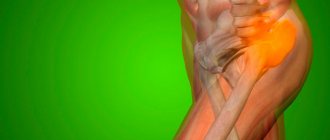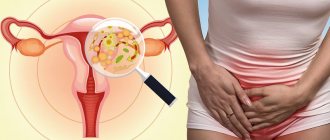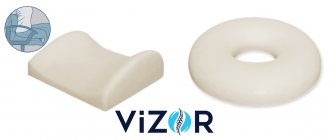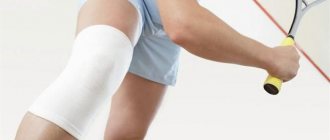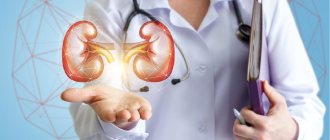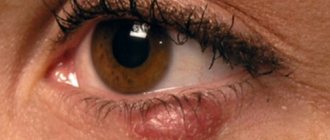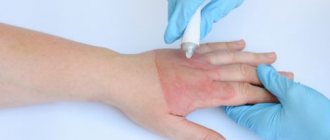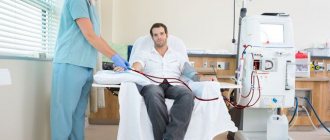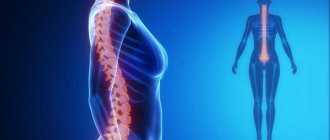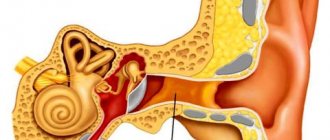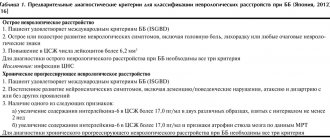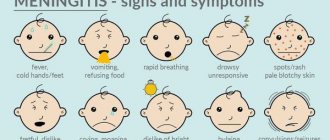Author
: Grachev Ilya Illarionovich
Editor
: Efremov Mikhail Mikhailovich
Date of publication: 05/13/2014 Date of update: 05/24/2021 All doctors of the clinic
- Elbow pain during/after coronavirus and ARVI
- Diagnostics
Pain in the elbow joint is not uncommon. It can be a consequence of injury, inflammation, tumor and a host of other diseases. Sometimes painful sensations occur against the background of various intoxications, previous infections and diseases of the internal organs. To figure out why elbow pain appears, you need to see a doctor. You can learn everything about the causes, symptoms and treatment of such conditions from this article.
Injuries
If the elbow joint hurts when pressed, you need to check for bruises, dislocations and sprains. Acute sensations may not appear immediately after the injury, but after 1-3 days. You can injure your hand at home, during training, or through excessive physical activity. Often, such a symptom is accompanied by swelling, a feeling of heat at the site of injury, difficulty in flexion and extension, and discomfort in the entire arm. Elbow pain that persists for more than 2 days, or even worsens, is a reason to immediately consult a doctor.
What exactly hurts
The elbow joint is a complex joint consisting of three bones (ulna, radius, humerus) and interconnected joints: radioulnar, humeroulnar and humeroradial. The radial side of the joint is on the outer (lateral) side of the arm, the ulnar side is on the inner (medial). The complex joint is surrounded by a dense capsule that protects it from external influences.
The inner lining of the capsule is called synovial. It secretes synovial fluid, which is the “lubricant” of the joint and supplies nutrients to the cells of the hyaline cartilage that covers the articular surfaces of the bones. Around the joint between the bone and tendon-ligament tissues there are 3 bursae - articular capsules containing synovial fluid (interosseous ulnar, radioulnar and ulnar subcutaneous). They improve the process of sliding of joint tissues during movement and prevent injury.
The joint is strengthened by four ligaments: two lateral (ulnar and radial), annular (fixes the head of the radius) and quadrate (fixes the connection of the radius and ulna). In the area of the elbow, the tendons of the flexor and extensor muscles of the shoulder are attached and the tendons of the forearm, which are involved in the movement of the arm below the elbow joint, originate. Joint movements: flexion-extension, supination-pronation (rotation of the forearm in and out).
The structure of the elbow joint
The elbow is the elbow joint and the soft tissues surrounding it - tendons, ligaments, blood vessels, nerves, subcutaneous tissue and skin. Elbow pain can occur due to pathology in any of these structures.
Osteoarthritis and osteoarthritis
Osteoarthritis is a disease of the joint with the destruction of cartilage and its other structures, as a result of which a person’s arms hurt in the elbow joints, inflammation appears and functions are impaired. A characteristic sign of osteoarthritis is marginal bone growths - osteophytes. Osteoarthritis is a disease without a pronounced inflammatory nature, caused primarily by wear and tear of the joint due to age-related changes, injuries or stress. In modern medicine, they have come to the conclusion that any process of destruction of joint tissue causes inflammation, so today these concepts, osteoarthritis and osteoarthritis, have become synonymous. With osteoarthritis, the elbow hurts with exertion. The destruction processes in this case develop due to the thinning of the cartilage inside the joint, which leads to a change in the structure of the ligaments and bones. In a relaxed state, the hand does not cause discomfort, but with strong pressure or other loads, for example, lifting a heavy bag, pain and burning appear. Without treatment, the disease can spread to other joints, worsening a person's overall well-being and quality of life. Unlike osteoarthritis (or osteoarthritis), arthritis of the elbow joint is a disease accompanied by a pronounced inflammatory process. Arthritis is manifested by severe swelling and local fever. Progressive arthritis of the elbow joint reduces the mobility of the limb and significantly reduces the amplitude of possible movements. Without proper treatment, the risk of joint contracture increases, a complication in which the arm is forced to be fixed in one position.
Causes of pain in the elbow joint
Traumatic injuries
The most common traumatic cause of pain is bruises.
They occur after a blow or fall on the elbow, manifest as moderate pain, which decreases over several days after the injury, and is accompanied by local swelling and some limitation of movements. With tears and ruptures of the ligaments, all symptoms are more pronounced, the pain syndrome intensifies when attempting passive movements in the direction opposite to the damaged ligament. With periarticular and intra-articular fractures of the lower end of the humerus, the upper part of the ulna, the neck and head of the radius, a sharp explosive pain occurs, which makes the eyes dark. Subsequently, the intensity of pain decreases, but the pain remains difficult to bear and intensifies with the slightest attempt to move the joint.
With fractures of the humeral condyles, fractures of the coronoid process, and Monteggia injuries, diffuse pain is felt deep in the joint. Fractures of the head and neck of the radius manifest as more localized pain in a specific area of the elbow. With olecranon fractures, pain is felt along the back of the elbow. Other symptoms of fractures are significant swelling, deformation, and severe pain with axial load.
Dislocations of the bones of the forearm are accompanied by unbearable pain, a clicking or crunching sound at the time of injury. Subsequently, the pain almost does not decrease until reduction. The joint is swollen, sharply deformed, active movements are impossible, and when passive movements are attempted, spring resistance is detected. In children under 5 years of age, after stretching or tugging on the arm, subluxation of the radial head sometimes occurs, which is manifested by moderate aching pain in the joint, which intensifies when trying to bend or palpate the ulnar fossa.
Inflammatory diseases of solid structures
Arthritis of the elbow joint is characterized by constant dull wave-like pain that intensifies in the early morning hours. The intensity of the pain varies from slight to very strong, depriving sleep and significantly limiting movement. The clinical picture is complemented by diffuse swelling, redness, local hyperthermia, stiffness, and dysfunction of the joint.
When infected, a severe variant of the disease develops - purulent arthritis, which is characterized by diffuse bursting, twitching or throbbing pain, combined with severe swelling, diffuse hyperemia, local hyperthermia, a significant increase in general body temperature, and symptoms of general intoxication.
Post-traumatic osteomyelitis of the periarticular ends of bones occurs after open injuries and operations on the joint, manifested by increasing sharp pain, rapid deterioration of the condition, general and local hyperthermia, and the appearance of purulent discharge from the wound. When transitioning to a chronic form, the pain becomes less intense, periodic, pulling or boring, and intensifies after exercise. A fistulous tract with purulent discharge is detected.
Hematogenous osteomyelitis affects the lower part of the humerus less often than the upper, and is detected in children. The pain quickly increases within 1-2 days, becomes tearing, throbbing, unbearable, intensifies even with minor attempts at movement, which makes patients “freeze” in bed. They are supplemented by general hyperthermia, chills, swelling, and redness of the joint.
Inflammatory pathologies of soft tissues
In acute aseptic bursitis, the pain is moderate, dull, bursting. Local edema, hyperthermia, and a fluctuating formation above the olecranon are observed. In the chronic form, the pain subsides, bothering mainly with pressure and physical activity. Swelling and redness disappear, the formation remains, the skin above it darkens. When infected, the pain syndrome increases sharply, the pain becomes tugging, bursting, and pulsating. The elbow turns red and swells. The temperature rises, symptoms of general intoxication appear.
Synovitis is not an independent pathology; it occurs with injuries and various diseases of the elbow joint. It manifests itself as a constant dull diffuse bursting pain, which intensifies as fluid accumulates. The joint increases in volume, its contours are smoothed. Upon palpation, fluctuation is determined.
Enthesopathies
A widespread cause of pain in the elbow joint is enthesopathies - inflammatory and degenerative lesions of the tendons at the point of their attachment to the bones. With lateral epicondylitis (tennis elbow), dull, stabbing or aching pain is localized along the outer surface of the joint, radiating to the shoulder and forearm. They intensify with load, extension of the middle finger with resistance. Combined with increasing weakness of the hand.
Medial epicondylitis is provoked by repetitive hand movements and occurs in golfers, gymnasts, tennis players, seamstresses, and typists. The symptoms are the same as for lateral lesions, but differ in localization - pain is felt inside, not outside the elbow; upon palpation and flexion of the hand, pain appears above the internal epicondyle of the shoulder.
Degenerative diseases
Arthrosis of the elbow joint in the initial stages is accompanied by unpleasant sensations, slight pain at the beginning of movements and after heavy loads. As the pathology progresses, the initial pain becomes more pronounced and is combined with stiffness; after exercise, the pain persists longer at rest. Movements in the joint are accompanied by crunching sounds.
Later, pain appears even with little physical activity, bothers you at night, and becomes constant, aching, pulling, and boring. The joint aches due to the weather. Movements are limited, and the ability to self-care suffers. Deformations of varying severity are formed, contractures develop.
With chondromatosis, loose bodies form in the joint, which can become pinched and impede movement. This determines the characteristics of the pain syndrome. Along with dull, pulling or aching pain, intensifying after physical activity, piercing (shooting, explosive) pain periodically occurs, which is combined with joint blocking.
Osteochondritis dissecans most often occurs in children and young people and is manifested by pain that increases throughout the year. First, there is discomfort without clear localization. Then moderate dull pressing or aching pain appears, combined with a slight crunching and “jamming”, blocking of the joint. Subsequently, the pain intensifies and then weakens, blockades become more rare.
Autoimmune diseases
The elbow joint is often affected by rheumatoid arthritis. The characteristics of pain depend on the activity of the rheumatic process. With grade 1, pain in the joint is insignificant, usually aching, appearing in the morning and after exercise, combined with transient stiffness. For grade 2, diffuse deep nagging pain at rest and during movement is typical.
During movement, the pain intensifies, which leads to limited function of the joint. Prolonged stiffness, recurrent effusions, and local redness of the skin are observed. At level 3 of activity, the pain is intense, constant, and exhausting. They are combined with severe local hyperemia, constant stiffness, persistent synovitis, severe limitation of mobility, development of subluxations and contractures.
For rheumatism, multiple joint damage is typical. Pain quickly migrates from one joint to another. The pain is strong and varies significantly in nature (sharp, dull, burning, pulsating, pressing, pulling). They arise after an acute infection, persist for several days, after which they disappear or significantly weaken.
With systemic lupus erythematosus, pain in the elbow joints is usually symmetrical. Several joints (shoulder, elbow, knee, etc.) on one side of the body may be affected. In mild cases, the pain is insignificant, short-term, local, dull. For a severe course, long-term progressive nagging or bursting pain is typical, which intensifies and weakens in waves, combined with swelling and hyperemia. Severe restrictions on mobility are uncommon.
Neoplasms
Benign neoplasia of the articular ends of bones, cartilage and surrounding soft tissue structures is characterized by a long course. The pain is insignificant, short-term, dull, nagging, with a fairly clear localization. Symptoms may remain unchanged for a long time. The growth of the tumor provokes an increase in pain; in some cases, due to compression of the nerves, radiating pain occurs, a sensation of “electric shock” or a shooting along the forearm.
Malignant tumors manifest themselves as rapidly progressive pain. Initially, the patient complains of a dull pain of uncertain localization with a tendency to intensify at night. Then the pain spreads throughout the joint, acquires a jerking, burning, bursting or cutting character, restricts movements, and is combined with local swelling, increasing deformity, asthenia, low-grade fever, and loss of appetite. At the final stage, the pain becomes constant, painful, unbearable, and can only be eliminated with narcotic drugs.
Other reasons
Ulnar nerve neuropathy and cubital tunnel syndrome manifest as nagging pain in the form of a strip from the internal epicondyle of the shoulder to the hand. Painful sensations are combined with numbness of the 4th and 5th fingers, intensifying when the joint is flexed. When pressure is applied to the elbow, there is a stabbing pain or sensation of lumbago from the elbow to the little finger.
Sometimes pain in the elbow occurs due to diseases of the cervical spine. This type of pain is characterized by a shooting sensation, spreading along the limb - from the shoulder to the hand. Irradiation of pain to the left elbow joint is possible with ischemic heart disease and myocardial infarction. Pain syndrome in this localization can also develop with mental illness and depressive disorders, taking corticosteroids and anabolic steroids.
Epicondylitis
If your arm hurts on the inside or outside of the elbows, epicondylitis can be suspected. It is also called the disease of tennis players and golfers: the destruction process affects the elbow joint, the surrounding tissues and muscles of the forearm - right or left, and extremely rarely - both. Ordinary movements are easy, but with monotonous exercises or increased loads, or performing rotational movements, a nagging pain in the elbow joint appears. Patients with epicondylitis react acutely to flexion and extension of the elbow, wrist and clenching of the hand into a fist. Permanent microdamage to the elbow joint leads to inflammation, impaired blood flow, scarring and muscle spasms. The disease especially often worries people over 40 years of age, whose profession involves constant “work with their hands” - athletes, machinists, drivers and even office workers.
Prevention of elbow pain
The health of the joints plays an important role because it has a direct impact on a person’s quality of life. Restriction in their movements and pain symptoms do not allow them to perform usual actions and reduce it. Preventive measures are as follows:
- A diet containing essential vitamins, microelements and substances beneficial to the body;
- The use of orthoses for intense loads on the joint;
- Performing exercises to strengthen ligaments and muscles;
- Elimination of hypothermia;
- Timely seeking professional medical help in case of loss of sensitivity and limited movement.
CELT specialists know how to restore your joy in life and relieve you of discomfort. Contact us!
Make an appointment through the application or by calling +7 +7 We work every day:
- Monday—Friday: 8.00—20.00
- Saturday: 8.00–18.00
- Sunday is a day off
The nearest metro and MCC stations to the clinic:
- Highway of Enthusiasts or Perovo
- Partisan
- Enthusiast Highway
Driving directions
Bursitis
Pain when bending and straightening the arm can also signal bursitis. When a joint is damaged, the cells of the synovial membrane actively produce fluid that accumulates inside the joint capsule. As a result, a characteristic lump or swelling usually forms on the outer side of the elbow, and the process of its enlargement is accompanied by pain, a local increase in temperature and redness of the skin. Acute bursitis is characterized by severe pain and limited range of motion. In the chronic form, a moderate burning sensation is felt, the elbow seems thickened. In some cases, bursitis leads to complications - a purulent process. To determine the specific type of disease, a puncture may be prescribed.
What to do at home if your elbow hurts
Elbow pain can appear suddenly in a person or increase gradually. Their causes can also be obvious (trauma, inflammation) or completely unclear (slowly developing chronic inflammatory and degenerative pathological processes).
In any case, if you experience constant pain, you should not:
- treat yourself with folk remedies or medicines that helped a neighbor;
- panic – all this can be treated, but only by specialists; You will be helped in a medical clinic, Moscow - the clinic’s specialists have extensive experience in the treatment of pain syndrome of the elbow joint.
How to treat a sore elbow at home
There is no point in delaying a visit to the doctor. But sometimes circumstances develop in such a way that pain in the elbow needs to be relieved urgently, but there is no way to see a doctor. To temporarily eliminate pain in the elbow, you can use medicinal and non-medicinal means, but you need to remember that this will not cancel a visit to the doctor:
- Painkillers in tablets:
- paracetamol (trade names Efferalgan, Panadol, Paracetamol) – for pain you can take a 500 mg tablet; contraindications: severe liver disease, chronic alcoholism;
- medications from the group of nonsteroidal anti-inflammatory drugs (NSAIDs) - ketoprofen (Ketonal, Artrum) has the most powerful analgesic effect; You can take a 100 mg tablet once; contraindications: gastrointestinal ulcers, severe kidney and liver diseases;
- nimesulide (Nise) is a medicine from the NSAID group that does not cause significant side effects from the gastrointestinal tract; for pain, you can take a 100 mg tablet.
- Pain-relieving ointments, creams, gels – applied externally and can be no less effective than tablets; Moreover, they have no side effects (except for allergies) and contraindications:
- ointments with diclofenac : Voltaren emulgel, Diclofenac gel;
- ointments with ketoprofen : Bystrumgel, Artrum gel, Ketonal cream and gel;
- ointments with nimesulide : gels Nise, Nimulid, Nimesulide.
- Injections (injections of medicinal solutions). Many patients do not have a medical education, so it is better to replace injections with rectal (introduced into the rectum) suppositories (suppositories). In terms of absorption rate and effectiveness, this corresponds to intramuscular injections. The following rectal suppositories can be used:
- Diclofenac – at a dose of 100 mg; contraindications: peptic ulcer of the stomach and duodenum;
- Ketonal – at a dose of 100 mg; contraindications as for Diclofenac;
- Indomethacin – 100 mg; contraindications, like Diclofenac.
Well, if you still know how to give injections, then you can administer 75 mg of Diclofenac intramuscularly (a medicinal solution of 3 ml is produced in ampoules, 25 mg in 1 ml, a total of 75 mg in an ampoule).
Drugs for treating acute pain in the elbows at home
Exercise therapy exercises will also help. If you experience significant pain before training, it is better to consult your doctor. But sometimes you can start doing the simplest light exercises on your own.
The main thing is to continue training every day, but do not overdo it, do not make sudden movements and do not continue training when the pain increases.
Effective exercises:
- bending all the way and straightening the arms at the elbows; repeat 15 times;
- rotational movements with arms bent at the elbows; do first 10 times to the left, then 10 to the right;
- simultaneous squeezing of a tennis ball with the right and left hands; repeat 10 times.
What not to do if you have elbow pain
If you have constant pain in your elbow, then you shouldn’t:
- lift weights;
- constantly perform the same professional movements with a load on the elbow joint; if this is not possible, then you should change your job or give up playing sports such as tennis, basketball;
- supercool;
- constantly expose yourself to stress and overload at work;
- smoking, regularly drinking alcohol;
- self-medicate.
When you need to see a doctor urgently
This must be done if you have pain in your elbow:
- accompanied by swelling and redness of the skin, increased body temperature;
- do not go away, despite eliminating stress and taking painkillers;
- accompanied by impaired movement and numbness of the hand;
- increase during movements in the joint;
- arise against the background of deformation of the elbow area.
If such symptoms appear, you cannot postpone visiting a doctor; this can lead to serious complications.
Osteochondritis dissecans
Osteochondritis dissecans is the death of a part of the bone, in this case in the elbow joint, in the area of the articular cartilage. With this pathology, cartilage tissue and a fragment of adjacent bone are separated and displaced into the joint cavity, causing pain - moderate and intensifying with movement. In later stages, symptoms such as “jamming” of the joint, a reduction in the range of motion, and chronic synovitis—inflammation of the joint membrane—are observed. The disease develops due to a local disturbance of blood flow in the elbow joint, most often occurring in men under the age of 30. Separately, it is worth noting such a dangerous symptom as a burning sensation in the shoulder or elbow of the left arm, associated with chest pain, decreased blood pressure and rapid pulse. Such signs may indicate the onset of a myocardial infarction, so if they are detected, you must urgently call an ambulance.
Treatment
Help before diagnosis
In case of injury, the arm is fixed with a splint or placed on a scarf. To reduce swelling and bleeding, cold is applied to the joint. If the pain is intense, the victim is given an anesthetic. It is necessary to avoid movements in the elbow joint and attempts to reduce it so as not to aggravate the damage.
For pain without previous injuries, the arm is given rest. In the absence of signs of acute inflammation, painkillers and warming agents are used. If there is a rapid increase in swelling, redness of the joint, intense pain, weakness, or increased body temperature, you should immediately see a doctor.
Conservative treatment
For dislocations and displaced fractures, reduction or reduction is performed. At the stage of outpatient or inpatient treatment, the patient is recommended a regimen that allows minimizing the manifestations of the pathological process and creating conditions for recovery. The regimen is selected individually and may include fixation with a plaster splint, suspension of the limb in a scarf, the use of orthopedic devices, or correction of motor activity.
Drug therapy includes NSAIDs and oral chondroprotectors, and topical agents. According to indications, chondroprotectors and glucocorticoids are injected into the joint. The elbow joint is considered “capricious”, that is, it often reacts negatively to physiotherapeutic treatment methods, so any procedures are prescribed with caution and only if there are sufficient indications. During the recovery stage, massage and physical therapy are used.
Surgical interventions
Surgeries on the elbow joint are performed using classic open access or minimally invasive arthroscopic techniques. Depending on the nature of the pathological process, the following groups of interventions are distinguished:
- traumatic injuries: osteosynthesis of the condyles of the shoulder and olecranon, resection of the head of the radius, open reduction of dislocation of the bones of the forearm or head of the radius;
- degenerative pathologies: removal of loose bodies, chondroplasty, arthroplasty;
- tumors: excision of neoplasia, segmental or marginal resection, shoulder amputation.
For contractures and ankylosis, taking into account the damage to soft tissue or hard structures, redressing, arthrolysis, arthroplasty or arthrodesis are performed. In some cases, the joint is replaced with an artificial implant during endoprosthetics.
Diagnosis of pain
For elbow pain, diagnosis begins with a consultation. The doctor conducts a survey to find out whether the patient has had any past or recent injuries, surgeries or treatments, and whether there are any hereditary factors that may affect the current condition of the joints. Next, the joint site is examined and felt (palpation), joint mobility and reaction to various positions of the limb are assessed. Most likely, to make a diagnosis you will have to visit several doctors - a surgeon, osteopath, neurologist, as well as a rheumatologist if you suspect rheumatoid arthritis - an autoimmune disease of the joints. A visit to a traumatologist may be required if there are injuries, dislocations, or sprains.
Since pain accompanies many diseases, the examination must exclude tumors and infections. Standard laboratory tests include blood and urine tests, as well as blood biochemistry. This list can be supplemented by tests prescribed by specialists: taking a sample of synovial fluid, tests for rheumatoid factor, C-reactive protein, etc. A comprehensive examination is necessary to timely and accurately determine the cause of the elbow joint disease.
In addition to examination, consultations and tests, diagnostics include:
- ultrasound examination - allows you to see damage to the structure of the joint, signs of inflammation, fluid accumulation, pathological changes in cartilage;
- radiography - shows the condition of the bones that form the joint, reveals bone growths, calcium deposits, deviations in the size of the joint space;
- computed tomography - helps to see all pathological, inflammatory and destructive changes in bone tissue;
- magnetic resonance imaging - reveals degenerative processes, tumors, injuries, foci of infections and inflammations.
Based on the diagnostic results, treatment is prescribed that eliminates the cause of elbow pain and alleviates the patient’s condition.
Features of the anatomical structure of the elbow
The elbow is a complex articular joint formed by the radius, ulna and humerus. Each bone involved in creating an articulation plays an important role and has certain characteristics:
- humerus - a tubular bone, the ends of which have strong differences (the upper one is predominantly rounded, and the lower one is triangular), which provides the opportunity for ideal articulation;
- ulnar - in combination with the radial one, forms the forearm, is thicker and resistant to external influences;
- radial - is a structural element of the forearm, is smaller in thickness, but is surrounded by an impressive muscle frame (a set of flexor/extensor and rotatory muscles).
The joint is nourished by a large number of veins and arteries. Innervation (supply of tissues with nerves) is realized thanks to large nerve fibers, which explains the increased sensitivity of the upper extremities.
How to alleviate the condition before starting treatment
Diagnosis may take several weeks, during which time the patient will experience pain. You can minimize discomfort by reducing physical activity - you will have to temporarily give up sports and any activities that cause pain symptoms. Ensuring complete immobility of the elbow at home is quite problematic, but until the end of the examination it is still worth minimizing any movements of the joint.
What to do if your elbow hurts very badly during exercise? First, you should stop the pain attack using anabolic steroids orally. Ointments with an analgesic effect, the effect of which is often based on warming up the skin, dilating blood vessels and increasing blood circulation in the problem area, are best postponed until the cause of the discomfort is clearly established. If the arm hurts in the elbow when lifting weights due to a malignant tumor, warming ointment can aggravate the situation and provoke the development of metastases.
Symptoms
Ulnar nerve neuritis has the following symptoms:
- paresthesia;
- decreased sensitivity of the palm surface in the area of the 4th and 5th fingers;
- decreased sensitivity of the dorsal surface - in the area of the 3rd, 4th and 5th fingers.
This condition is also characterized by weakness in the muscles of the 4th and 5th fingers, hypotrophic and atrophic changes in the muscles of the eminence of the thumb and little finger, the lumbrical and interosseous muscles of the hand. As a result of muscle atrophy, the palm acquires a flattened shape and, as a result of the bending of the middle phalanges of the fingers, it becomes similar to a paw with claws.
Frequently asked questions about the disease
Which doctor treats elbow arthritis?
Rheumatoid, psoriatic – rheumatologist, acute purulent – surgeon; post-traumatic and deforming arthrosis-arthritis – traumatologist.
Can you join the army with elbow arthritis?
If there is a violation of joint function, then no.
My elbow has been hurting for several months now after an injury. What to do?
See a doctor and get examined. Once the cause of the disease is determined, you will be prescribed treatment.
If you suspect arthritis of the elbow joint, you should not self-medicate. It is necessary to immediately consult a doctor before joint dysfunction occurs. The Paramita clinic will definitely help you!
Literature:
- Asin B.A., Pavlov V.P., Zagorodniy N.V. Surgical treatment of elbow joint arthritis in patients with rheumatoid arthritis. Scientific and Practical Rheumatology, 1982; 2, 7.
- Brion PH, Kalunian KC; Oxford textbook of medicine. 4th edn. Oxford: Oxford University Press. Section 18.8. Osteoarthritis (2003) Warrell DA, Cox TM, Firth JD, Benz EJ Jr(Eds.)
- Reichenbach S, Sterchi R, Scherer M, et al; Meta-analysis: chondroitin for osteoarthritis of the knee or hip. Ann Intern Med. 2007 Apr 17;146(8):580-90.
- Herrero-Beaumont G, Ivorra JA, Del Carmen Trabado M, et al; Glucosamine sulfate in the treatment of knee osteoarthritis symptoms: a randomized, double-blind, placebo-controlled study using acetaminophen as a side comparator. Arthritis Rheum. 2007 Feb;56(2):555-67.
Themes
Arthritis, Joints, Pain, Treatment without surgery Date of publication: 12/09/2020 Date of update: 03/12/2021
Reader rating
Rating: 5 / 5 (1)
MBST therapy
MBST therapy uses a device that emits magnetic pulses. Using the procedure you can achieve the following results:
- improve blood microcirculation, accelerate the outflow of blood and lymph;
- prevent further development of pathological processes;
- speed up the rehabilitation period;
- get rid of unpleasant symptoms;
- The procedure promotes rapid tissue healing.
You can sign up for the MBST therapy procedure at ArthroMedCenter.
Why you shouldn't self-medicate
We have already said that loss of mobility of the elbow joint can be a consequence of dangerous conditions: pain in this area can be caused by disorders in the spine and even the brain.
A situation in which a patient buys a “universal” ointment advertised on TV and tries to relieve pain with it is fraught with aggravation of the condition. During self-treatment, the acute inflammatory process and disturbances in the passage of nerve impulses may intensify. And if at the initial stage they can be eliminated by methods of manual therapy and drug treatment, then in an advanced situation surgical intervention will most likely be required.
